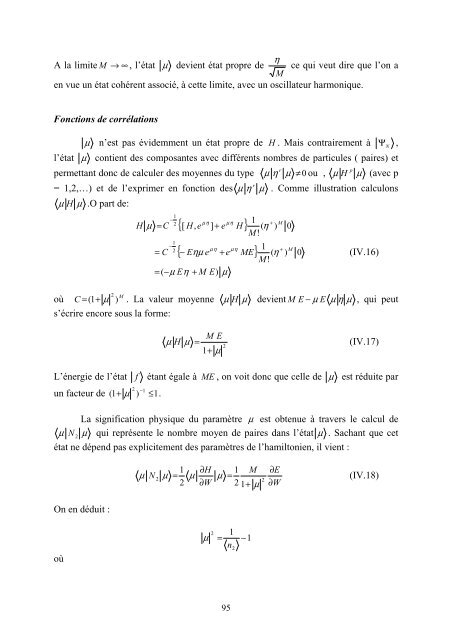Annexe IV Modèle de Hubbard standard et états cohérents - Toubkal
Annexe IV Modèle de Hubbard standard et états cohérents - Toubkal
Annexe IV Modèle de Hubbard standard et états cohérents - Toubkal
Create successful ePaper yourself
Turn your PDF publications into a flip-book with our unique Google optimized e-Paper software.
ηA la limite M → ∞ , l’état µ <strong>de</strong>vient état propre <strong>de</strong> ce qui veut dire que l’on aMen vue un état cohérent associé, à c<strong>et</strong>te limite, avec un oscillateur harmonique.Fonctions <strong>de</strong> corrélationsµ n’est pas évi<strong>de</strong>mment un état propre <strong>de</strong> H . Mais contrairement à ΨN,l’état µ contient <strong>de</strong>s composantes avec différents nombres <strong>de</strong> particules ( paires) <strong>et</strong>perm<strong>et</strong>tant donc <strong>de</strong> calculer <strong>de</strong>s moyennes du type µ ηr pµ ≠ 0 ou , µ H µ (avec p= 1,2,…) <strong>et</strong> <strong>de</strong> l’exprimer en fonction <strong>de</strong>s µ ηr µ . Comme illustration calculonsµ H µ .O part <strong>de</strong>:oùH µ = C= C1−21−2µη µη{[H,e ] + e H}µη µη{ − Eηµe + e ME}= ( −µEη+ M E)µ2 M= (1 + µ . La valeur moyenne µC )s’écrire encore sous la forme:1M!+( η )1M!M+( η )0M0(<strong>IV</strong>.16)µ H <strong>de</strong>vient M E − µ E µ η µ , qui peutM Eµ H µ =(<strong>IV</strong>.17)21 + µL’énergie <strong>de</strong> l’état f étant égale à ME , on voit donc que celle <strong>de</strong> µ est réduite par−1un facteur <strong>de</strong> (1+µ ) ≤1.2La signification physique du paramètre µ est obtenue à travers le calcul <strong>de</strong>N µ qui représente le nombre moyen <strong>de</strong> paires dans l’état µ . Sachant que c<strong>et</strong>µ2état ne dépend pas explicitement <strong>de</strong>s paramètres <strong>de</strong> l’hamiltonien, il vient :1 ∂H1 M ∂Eµ N2µ = µ µ =(<strong>IV</strong>.18)22 ∂W2 1+µ ∂WOn en déduit :oùµ21= n2−195
















